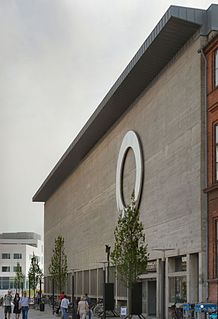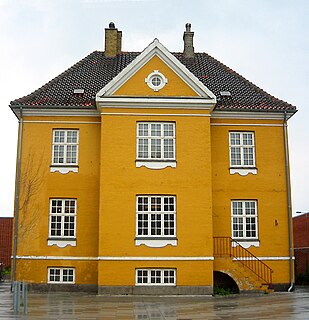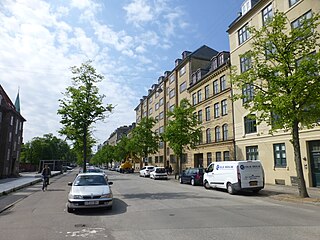
Bikuben Kollegium (Danish: Bikuben Kollegiet) is a privately owned dormitory for students in Ørestad, Copenhagen. [1]

Danish is a North Germanic language spoken by around six million people, principally in Denmark and in the region of Southern Schleswig in northern Germany, where it has minority language status. Also, minor Danish-speaking communities are found in Norway, Sweden, Spain, the United States, Canada, Brazil, and Argentina. Due to immigration and language shift in urban areas, around 15–20% of the population of Greenland speak Danish as their first language.

A dormitory is a building primarily providing sleeping and residential quarters for large numbers of people such as boarding school, high school, college or university students. In some countries, it can also refer to a room containing several beds accommodating people.

Ørestad is a developing city area in Copenhagen, Denmark, on the island of Amager. When the area was planned it was expected that 20,000 people would live in Ørestad, 20,000 would study, and 80,000 people would be employed in the area. However, so far the area has failed to attract even half of those numbers. The area is being developed using the new town concept with the Copenhagen Metro as the primary public transport grid, connecting the area with the rest of Metropolitan Copenhagen.
Opening in August 2006, Bikuben Kollegium is located on the corner of Amager Fælledvej and Njalsgade next to the University of Copenhagen's South Campus. [1] The dorm was designed by the Aart Architects, an Aarhus based firm having as its ambition to make new forms of student communities possible. Kitchens and common areas are thus distributed on various floors, facing an inner yard. [2]

The University of Copenhagen (UCPH) is the oldest university and research institution in Denmark. Founded in 1479 as a studium generale, it is the second oldest institution for higher education in Scandinavia after Uppsala University (1477). The university has 23,473 undergraduate students, 17,398 postgraduate students, 2,968 doctoral students and over 9,000 employees. The university has four campuses located in and around Copenhagen, with the headquarters located in central Copenhagen. Most courses are taught in Danish; however, many courses are also offered in English and a few in German. The university has several thousands of foreign students, about half of whom come from Nordic countries.

The South Campus is one of University of Copenhagen's four campuses in Copenhagen, Denmark. It is situated on Amager just south of Njalsgade, between Ørestad Boulevard and Amager Fælledvej, forming the northernmost part of Ørestad. It is home to the Faculty of Humanities which will later be joined by the Faculty of Theology and the Faculty of Law. Once completed, the campus will be home to about 12,000 students and researchers.
AART architects is an architectural firm based in Aarhus, Denmark. With several winning projects in international architecture competitions AART architects is one of the leading architectural firms in Denmark. Over the years their work has received several honorary awards and been exhibited internationally in places like the Venice Biennale, La Galerie d'Architecture in Paris and the European Parliament in Brussels.
The dormitory has 96 one room dwellings and four two room apartments as well a small number of homes for handicapped students and families. There are also furnished rooms, reserved for foreign students. [1] The rent is DKK 2,985 per month for the smallest type of room. [1]

According to many definitions, a disability is an impairment that may be cognitive, developmental, intellectual, mental, physical, sensory, or some combination of these. Other definitions describe disability as the societal disadvantage arising from such impairments. Disability substantially affects a person's life activities and may be present from birth or occur during a person's lifetime.
Disabilities is an umbrella term, covering impairments, activity limitations, and participation restrictions. An impairment is a problem in body function or structure; an activity limitation is a difficulty encountered by an individual in executing a task or action; while a participation restriction is a problem experienced by an individual in involvement in life situations. Disability is thus not just a health problem. It is a complex phenomenon, reflecting the interaction between features of a person’s body and features of the society in which he or she lives.

The krone is the official currency of Denmark, Greenland, and the Faroe Islands, introduced on 1 January 1875. Both the ISO code "DKK" and currency sign "kr." are in common use; the former precedes the value, the latter in some contexts follows it. The currency is sometimes referred to as the Danish crown in English, since krone literally means crown. Historically, krone coins have been minted in Denmark since the 17th century.
The light art which can be seen at the entrance was created by the artist Viera Collaro. [1]

Light art or luminism is an applied art form in which light is the main medium of expression. It is an art form in which either a sculpture produces light, or light is used to create a "sculpture" through the manipulation of light, colours, and shadows. These sculptures can be temporary or permanent, and can exist in two distinctive spaces: indoor galleries, such as museum exhibits, or outdoors at events like festivals. Light art can be an interaction of light with in an architectural space. Light artists are those that devote all their creative experimentation to light art, some artists experiment with light and neon signage and use light in their practice.

Viera Collaro is a Slovak-Danish artist whose work in light art relies on the effects of light on colour, space and reflection. In addition to her artworks and installations, since the early 1990s she has decorated a number of Danish buildings including Copenhagen University's South Campus on Amager. In 2002, she was awarded the Eckersberg Medal and in 2015, she received the prestigious Thorvaldsen Medal.
Among a lot of dormitories in the area, Grønjordskollegiet is located 1 km South of Bikuben Kollegiet.

Grønjordskollegiet is a dormitory situated on Amager, Copenhagen, up to natural area Amager Fælled by Grønjordssøen. The dormitory is one of Denmark's largest with 920 rooms and approx. 1000 residents. The College consists of 5 blocks with 8 floors each with 21 single rooms and 2 double rooms.
















